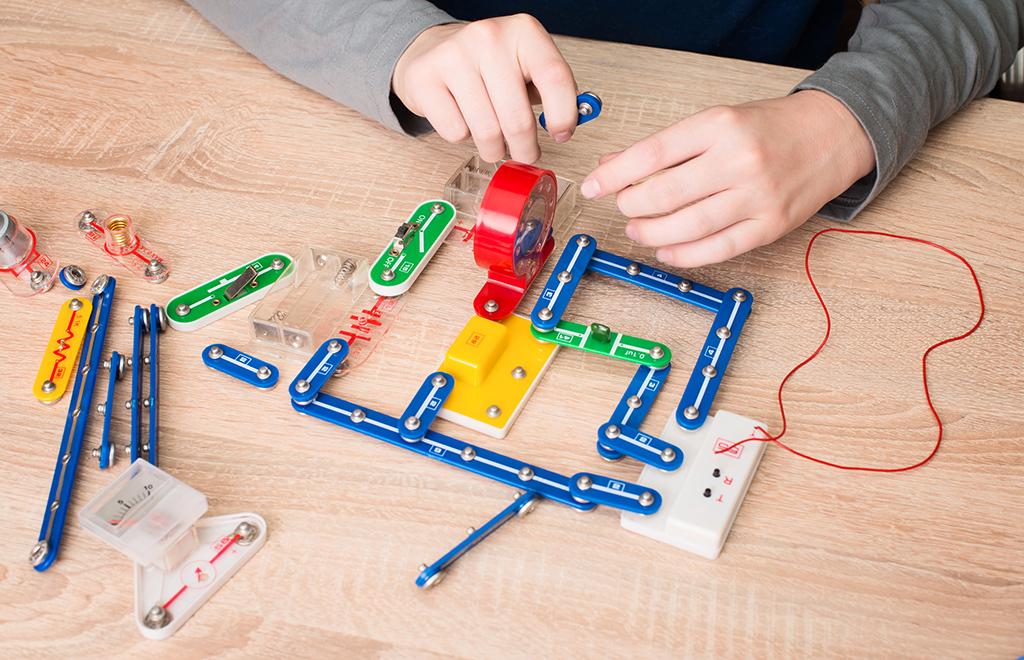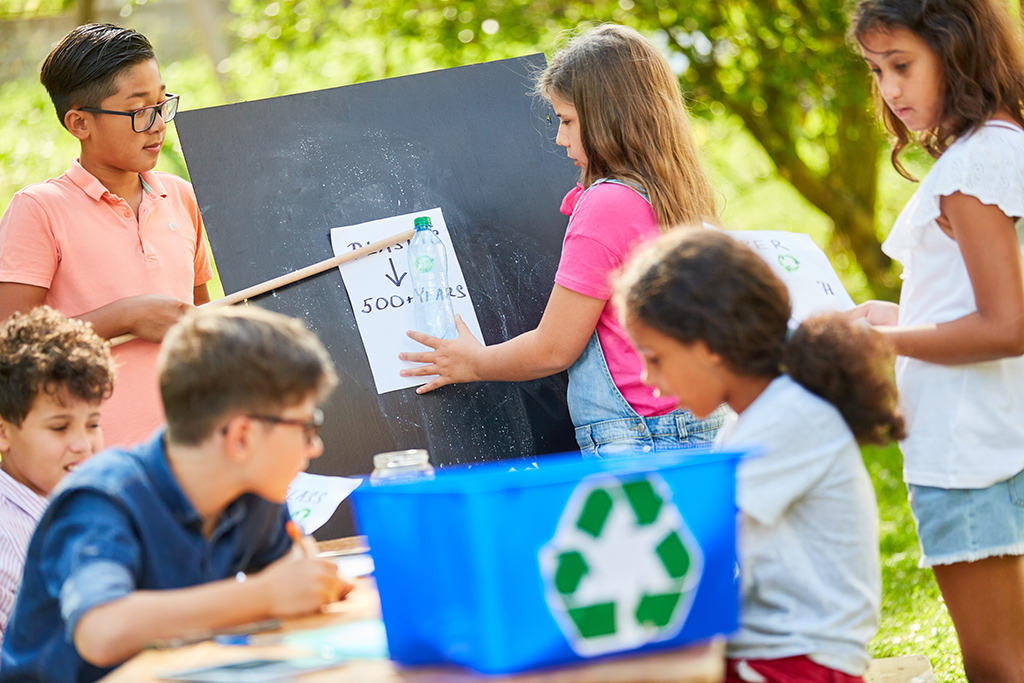What is Project Based Learning?
Project-based learning (PBL) is an instructional approach that structures curriculum into real-world tasks which encourage students to design, create, and refine solutions over time, often in groups. PBL encourages students to use critical thinking and problem-solving skills to develop deeper understanding of academic content. PBL can involve extended periods of time as students work together in teams to investigate real-world challenges and apply their knowledge in meaningful ways. This approach helps students gain a greater understanding of content by engaging in active learning experiences that are relevant to the real world. Through PBL, students have the opportunity to explore complex questions, apply their knowledge within a context, and create meaningful solutions with real-world applications.
PBL can be traced back to educational philosophies documented in the 1800s by educators such as John Dewey, who wrote My Pedagogical Creed in 1897. Dewey became a well-known education reformer in the 20th century, popularizing his idea of “learning by doing.”
Another, related teaching strategy is problem-based learning, which also uses real-world examples in a student-centered situation to promote deeper learning. Unfortunately, it also produces the same acronym, PBL. Some institutions use these 2 meanings of PBL interchangeably, but for the purposes of this article, we will be taking a look at project-based learning.
Before PBL, establish student strengths and challenges
Benefits of Project Based Learning
Why should teachers use PBL? This approach to learning encourages critical thinking, self-directed inquiry and problem solving skills, while encouraging deep content knowledge. Through PBL, students are able to explore real-world applications of their academic content and engage in meaningful activities that reflect the complexity of the real world. Additionally, it can foster student engagement as it encourages collaboration and communication among peers. PBL allows students to gain practical experience in a variety of contexts that are often more relevant than traditional teaching methods.
Accomplished teachers who use project-based learning in their classrooms don’t just break students into groups and then send them off to work on their own. They elicit higher-order thinking skills by providing students with challenging problems or issues to investigate. Research shows that students in project-based learning are better equipped to use knowledge outside the classroom.
In May, 2014, Gallup Education released the inaugural Gallop-Purdue Index, the largest representative study of college graduates in US history. The purpose of this study was to discover how happy, thriving adults achieve success, and specifically, what aspects of their education helped steer them on the better course, if any. What they found was surprising. After studying more than 30,000 US college graduates for over a decade, the study discovered that long-term, project-based learning at school was one of the 3 key ingredients in developing the grit and resilience to succeed later in life. The other two involved experiencing real-world internships and mentoring. Since virtually any age student can get involved with project-based learning, let’s take a closer look at what that really means.
Core Principles of Project-Based Learning
At its core, PBL consists of four principles: meaningful and challenging tasks, student engagement in the learning process, authentic contexts for application and assessment of student learning. By focusing on these core elements, students are able to gain the expertise necessary to become thoughtful problem solvers.
Meaningful tasks provide students with an opportunity to apply their academic knowledge and skills while also developing deeper understanding of the subject matter. Challenges should be age-appropriate and scaffolded so that they encourage collaboration among peers and support inquiry-based learning. Student engagement should be encouraged so that learners feel supported as they explore complex questions, analyze data and develop actionable solutions. Authentic contexts provide a realistic backdrop for students to consider real-world issues and create solutions that have implications beyond the classroom walls. Finally, assessment should involve evaluating both process (e.g., collaboration) and product (e.g., presentation), in addition to curriculum outcomes.
Before a project begins, teachers should establish a knowledge baseline using a variety of different assessment strategies appropriate for the project, then conduct the same assessments afterwards. Progress monitoring and formative assessments in learning domains used in the project are common ways to assess student learning. Robust assessments in general topics such as reading and math also provide insight into overall learning progress. Let’s Go Learn gives teachers and students a deep understanding of strengths and weaknesses in math and reading through its diagnostic assessments.
Create an educational baseline for your projects
By incorporating these core principles into project-based learning activities, educators can help foster deep understanding of specific content areas, such as social studies or STEM, while also providing valuable opportunities for students to hone problem-solving skills in core reading and math over an extended period of time.
Relevance to Real-World Applications
PBL places a strong emphasis on preparing students for real-world applications. By providing meaningful tasks and engaging contexts, PBL enables students to gain deeper understanding of content knowledge while also developing their problem-solving skills. Through authentic projects, students learn to apply their academic knowledge to real-world problems and develop the ability to think critically about relevant issues. This helps them become better equipped for future success in college and career. With project-based learning, educators can therefore provide learners with an opportunity to explore complex questions, analyze data and develop actionable solutions that will help them succeed in the 21st century job market.
Inquiry-Based Learning Approach
Another related teaching method is inquiry-based learning (IBL). This strategy focuses on student-directed investigation and exploration. It encourages students to ask questions, explore ideas, and develop theories based on their findings. This approach allows learners to construct their own understanding of the subject matter through active engagement with the material. IBL promotes deeper learning by allowing students to connect what they are learning in the classroom to real-world experiences and challenges. As such, it encourages them to think critically about how the academic content can be applied outside of the classroom setting. Additionally, IBL encourages collaboration between students as they work together to solve problems and uncover solutions. With IBL, educators can help their students develop key competencies such as critical thinking and problem-solving skills which will prove invaluable for success in college and beyond.
Complex Questions and Deeper Understanding
Project-based learning encourages students to develop deeper understanding of the subject matter by engaging in complex questions and real-world applications. Students are presented with a problem or challenge that they must solve by applying their existing knowledge and conducting further research. This allows them to gain a deeper understanding of the material, as well as develop important skills such as critical thinking, problem-solving, and communication. Additionally, project-based learning often requires an extended period of time for completion which allows students to become more engaged in the learning process since they are actively working towards reaching a goal.
Student Engagement and Active Learning
Student engagement and active learning are essential elements of successful project-based learning. PBL encourages students to be actively involved in the process of discovering solutions to real-world issues and challenges. By engaging in hands-on exploration and investigation, students develop a deeper understanding of the content knowledge as well as problem-solving skills. Additionally, through working collaboratively with peers, students gain valuable social and interpersonal skills that will benefit them long after the completion of their projects.

Authentic Assessments and Evaluations
In addition to general knowledge assessments, authentic project goal assessments and evaluations are an essential part of effective project-based learning. By assessing student learning through real-world applications, educators gain insight into the learning process and ensure that students are obtaining a deeper understanding of the academic content. Through authentic assessments, teachers can evaluate student performance based on their ability to use knowledge in real-world situations, as well as their success in completing extended projects over an extended period of time. Additionally, authentic assessment provides teachers with evidence for determining if the project-based learning approach has been successful in meeting its goals. As such, it is important for educators to incorporate authentic assessment into their project-based learning approach in order to measure the effectiveness of their teaching methods and better understand student progress.
Providing Sample Projects
Before beginning a project, educators should have access to examples of projects that have been used successfully in the classroom. Fortunately, there are numerous resources available offering sample projects to help teachers get started with project-based learning. These resources provide teachers with step by step instructions on how to design their own project as well as example projects they can use as inspiration or templates. Sample projects can be found online or through professional development organizations and allow teachers to quickly become familiar with the project-based approach and begin planning their own successful projects. With the right resources, educators can ensure students gain the most out of their project-based learning experience.
Challenges of Project-Based Learning
Project-based learning can be a powerful teaching tool, offering students opportunities to engage with academic content and develop their problem-solving skills. However, it is not without its challenges. One of the biggest challenges in project-based learning is finding the right problems or topics that will engage students and help them gain deeper understanding. Additionally, projects may require an extended period of time to complete, which means student engagement must be maintained throughout the learning process. Project-based learning also requires instructors to take on a more coach-like role instead of simply instructing students on content knowledge. Finally, there are curriculum considerations when creating projects that require real-world applications and complex questions. Despite these challenges, educators can find support through resources providing sample projects and through professional development organizations. With the right guidance and planning, educators can create successful project-based learning experiences for their students.
Of course, PBL is not without its critics. The primary concerns are its potential lack of rigor and structure, and its potential to be overly time-consuming. Critics argue that project-based learning can easily become unfocused if not properly planned and managed by educators. Additionally, some critics argue that project-based learning can lead to a lack of accountability from students, with some students potentially coasting through projects. Others have questioned the feasibility of implementing projects in subjects such as mathematics or science, where more standard teaching methods may be better suited for mastery of specific skills. However, with proper planning and guidance, educators can create effective project-based learning programs that involve real-world challenges and allow students to explore deeper understanding of core academic content.
The many other benefits of PBL seem to outweigh these criticisms, and should inspire teachers to invest in the assessments, structure, and resources required to build projects into the curriculum.
Project-Based Learning Examples
PBL can involve working on projects individually or in teams, researching complex questions and tackling real-world problems through experiential activities. By using this approach, teachers can help students develop critical thinking skills, foster deeper understanding of content knowledge, and encourage student engagement with the learning process. Examples of PBL activities include visiting zoos to learn about animal habitats and then presenting a research-supported habitat plan or model to professional zoologists; reading a controversial book and then taking part in a censorship-related mock trial experience; and creating projects to explore real-world issues in social studies. With proper planning and guidance from educators, project based learning activities can be an effective way to engage students in meaningful learning experiences.
Some popular PBL categories include:
- STEM projects
- Art projects
- Garden projects
- Community service projects
- Classroom projects
- Internet research projects
- Student conferences
- Chemistry experiments
- Business simulations
- Historical simulations
- Mechanical invention explorations
- Journalism and critical thinking projects
- Student podcasts or videos
- A series of projects along a common theme

Project-Based Learning Lesson Plans
PBL lesson plans are an invaluable resource for educators seeking to create meaningful learning experiences for their students. PBL lesson plans provide teachers with the opportunity to incorporate real-world challenges, inquiry-based learning, and active learning into their curriculum. Furthermore, these lessons can be tailored to align with academic content standards while providing a deeper understanding of concepts. For example, many PBL lesson plans focus on problem-solving skills by having students design solutions to current issues using mathematical models or explore real-world situations in social studies. Additionally, some PBL lessons may require an extended period of time in order for students to gain a real-world experience. By incorporating PBL lessons into the classroom, teachers can help foster deeper learning and encourage student engagement with the learning process.
Renton Technical College in Washington State keeps a nice list of PBL lesson plan resources on this web page.
Getting Started With Project-Based Learning
Getting started with project-based learning can be intimidating for many teachers. Teachers should not simply have students do projects; there should be some curriculum, thought, and rigor built into the projects. Projects in PBL should help build long-term retention of curriculum and require the application of knowledge and critical thinking, not just recall. By taking a few steps and starting small, teachers can successfully incorporate PBL into their classrooms.
First, it is important to understand the purpose of PBL as well as its potential benefits. This includes understanding how PBL encourages critical thinking and problem-solving skills in students while providing real-world applications of content knowledge. Next, explore existing projects or create your own to ensure that the project aligns with academic standards and addresses complex questions that students may have about the subject matter. Finally, set reasonable timeframes for completing the project and provide feedback to students throughout the process. By taking these steps, teachers will be able to successfully implement project-based learning in their classrooms and help foster deeper student engagement in the learning process.
A good place to start is PBLWorks.org, which provides the training and examples to get teachers up to speed.
PBL Professional Development
Teacher training is essential in order to ensure successful implementation of project-based learning (PBL). Professional development workshops and courses can help teachers learn the best practices for designing and delivering high-quality PBL projects. These training sessions provide teachers with the tools they need to create engaging, meaningful assignments that encourage deeper understanding of course content and real-world problem-solving skills. Additionally, these trainings reinforce the importance of inquiry-based learning and active engagement. By equipping teachers with the knowledge and resources necessary for successful PBL implementation, educators are better able to provide their students with a rich and beneficial learning experience.
The US Department of Education offers a wonderful, free video-based introduction to project-based instruction for teachers. This professional development series is part of the You for Youth (Y4Y) program, and offers certificates of completion for participating.
References
- https://www.pblworks.org/
- https://y4y.ed.gov/learn/pbl/
- https://www.gse.harvard.edu/news/uk/22/01/project-based-learning-great



Leave A Comment